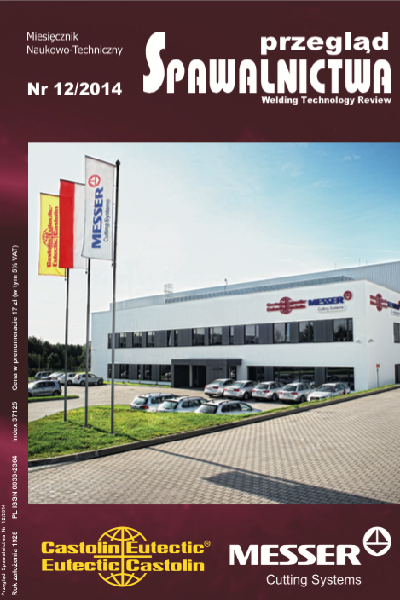Badania mikrostruktury i mikrosegregacji składu chemicznego warstw ze stopu Inconel 625 napawanych techniką CMT na podłoże ze stali 16Mo3
##plugins.themes.bootstrap3.article.main##
Abstrakt
Streszczenie
Celem pracy była ocena mikrostruktury i składu chemicznego napoin ze stopu Inconel 625 napawanych metodą CMT na podłoże ze stali 16Mo3 oraz segregacji dendrytycznej (mikrosegregacji) pierwiastków stopowych następującej podczas krzepnięcia napoiny. Badania prowadzono za pomocą mikroskopu świetlnego Axio Imager MAT. M1m firmy Carl Zeiss oraz skaningowych mikroskopów elektronowych: mikroskopu nanoSEM 450 firmy FEI wyposażonego w detektor EDS firmy EDAX oraz mikroskopu Hitachi S-3500n wyposażonego w detektor EDS firmy noran. Wykazano, że w wyniku mikrosegregacji zachodzącej w trakcie krzepnięcia napoin rdzenie dendrytów bogatsze są w Ni, Fe i Cr, natomiast obszary międzydendrytyczne w Mo i Nb. Podczas krzepnięcia najsilniej segreguje niob, w mniejszym stopniu molibden, natomiast najmniej segreguje chrom. Pomimo, że Inconel 625 jest stopem umacnianym roztworowo to w przestrzeniach międzyden- drytycznych napoin tworzą się fazy bogate w nb i Mo.
Abstract
The aim of this work was to investigate the microstruc- ture and chemical composition of Inconel 625 coatings on a 16Mo3 steel overlaid by the CMT method as well as mi- crosegregation of alloying elements during solidification of weld overlay.
The investigations were carried out with an Axio Imag- er MAT. M1m light microscope (LM) manufactured by the Carl Zeiss company and with a FEI nanoSEM 450 and Hitachi S-3500n scanning electron microscopies (SEM).
The investigation showed that microsegregation oc- curring during the weld overlay solidification makes the dendrite cores to be richer in Ni, Fe and Cr while the interdendritic areas in Mo and nb. niobium shows the strongest tendency to segregation during solidification; molybdenum tends to segregate less and chromium has the lowest tendency to segregation. Although Inconel 625 is a solid solution strengthened alloy, nb and Mo-rich phases are formed in the between dendrite arms of weld overlays.
Pobrania
##plugins.themes.bootstrap3.article.details##
Creative Commons CC BY 4.0 https://creativecommons.org/licenses/by/4.0/
Artykuły czasopisma Welding Technology Review (Przegląd Spawalnictwa) publikowane są w otwartym dostępie na licencji CC BY (licencja Creative Commons Uznanie autorstwa 4.0 Międzynarodowe). Licencja CC BY jest najbardziej otwartą dostępną licencją i uważaną za „złoty standard” w formule otwartego dostępu; jest również preferowany przez wielu fundatorów badań. Licencja ta umożliwia czytelnikom kopiowanie i redystrybucję materiału na dowolnym nośniku i w dowolnym formacie, a także zmienianie, przekształcanie lub budowanie na nim materiału, w tym do użytku komercyjnego, pod warunkiem wskazania oryginalnego autora.
Bibliografia
Cieslak M. J.: The welding metallurgy of custom age 625 plus alloy. welding research supplement. 16 (1989) 473-482.
Kou S.: welding metallurgy. A John wiley & Sons, InC., Pu-
blication, 2009.
DuPont J. n.: Microstructural evolution and high temperature
failure of ferritic to austenitic dissimilar welds. International
Materials Reviews.57 (4) (2012) 208-234.
Rozmus-Górnikowska M., Blicharski M., Kusiński J.: Influen-
ce of boiler pipe cladding techniques on their microstructure
and properties. Archives of Metallurgy. 4 (2013) 1993-1996.
DuPont J. n.: Solidification of an alloy 625 weld overlay. Me- tallurgical and Materials Transactions A. 27 A (1996) 3612-
Cieslak M. J.: The welding and solidification metallurgy
of alloy 625. welding Research Supplement. (1991) 49-56.
Silva C. C., Miranda H. C., Motta M. F., Farias J. P., Afonso C. R. M., Ramires A. J.: new insight on the solidification path of an alloy 625 weld overlay. Journal of Materials Research
and Technology. 2 (3) (2013) 228-237.
Pickin C.G., williams S.w., Lunt M.: Characterization of the cold metal transfer (CMT) process and its application for low dilution cladding. Journal of Materials Processing -Technology. 211 (2011) 496-502.
Bruckner J.: Metoda CMT- rewolucja w technologii spawa- nia. Przegląd Spawalnictwa. 81 (7-8) (2009) 24-28.
Rozmus-Górnikowska M., Blicharski M., Kusiński J.: Influen- ce of weld overlaying methods on microstructure and chemi- cal composition of Inconel 625 boiler pipe coatings. Metallic Materials. 52 (3) (2014) 1-7.
Blicharski M.: Zmiany mikrostruktury w połączeniach spawa- nych różnoimiennych materiałów stosowanych w energety- ce. Przegląd Spawalnictwa. 85 (3) (2013) 2-13.
DuPont J. n., Lippold. J. C., Liser S. D.: welding metallur- gy and weldability nickel base alloys. A John wiley & Sons, InC., Publication, 2009.
